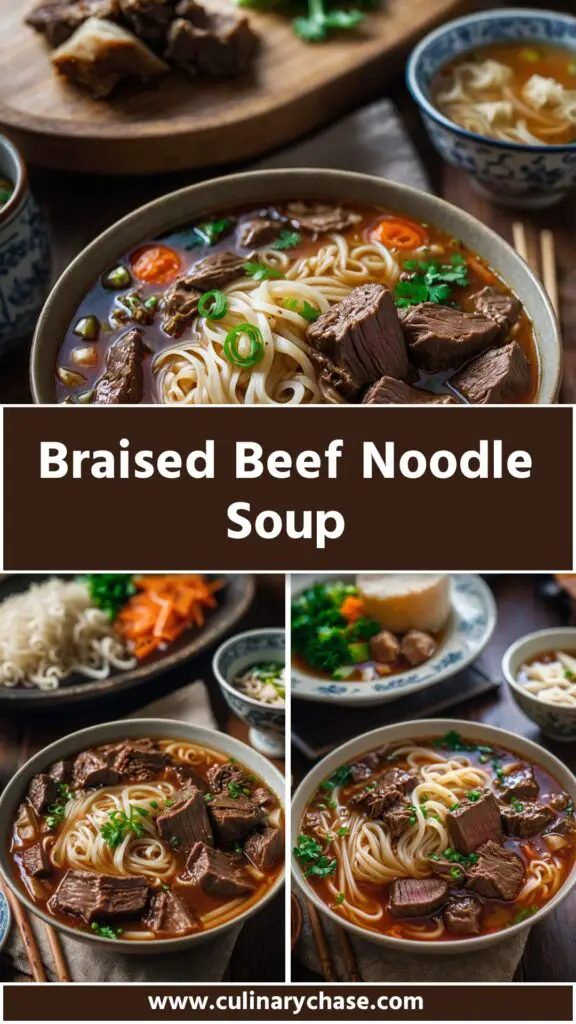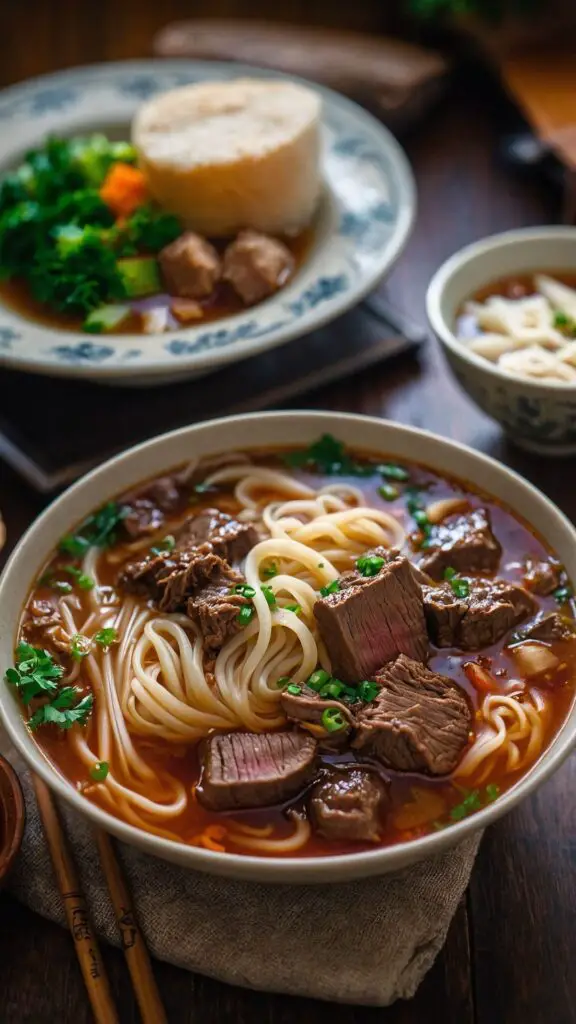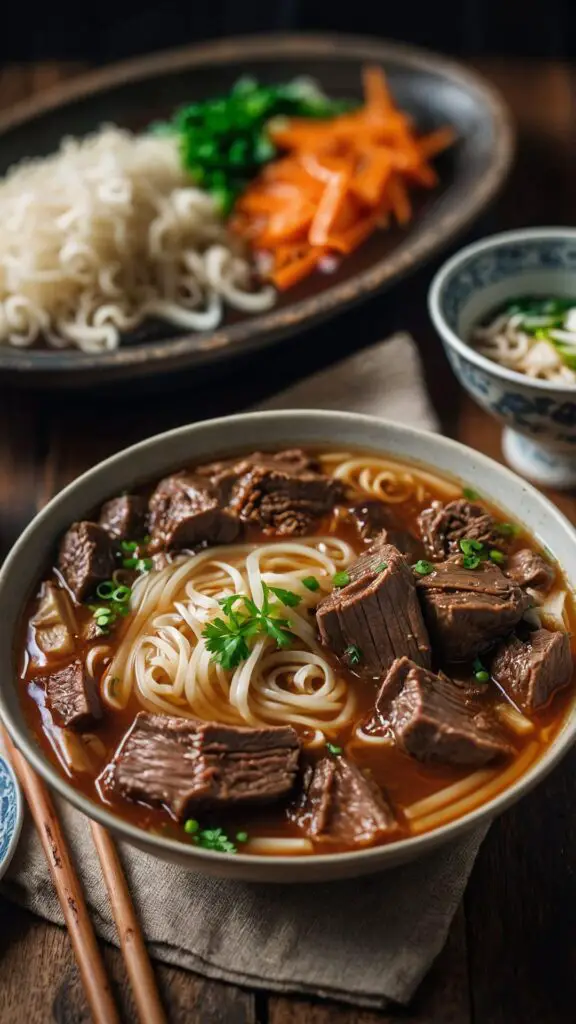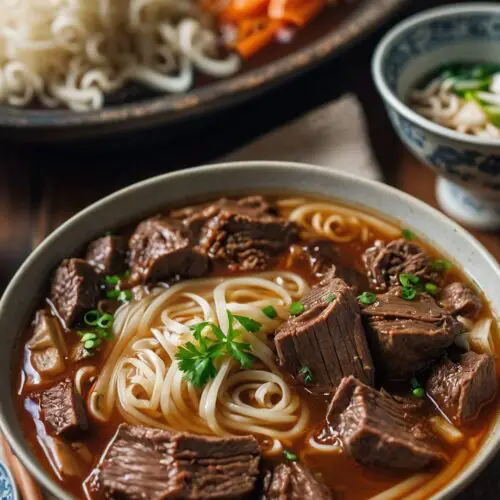Braised Beef Noodle Soup – Culinary Chase
Before diving into the world of braised beef noodle soup, let’s chat about what you can enjoy with this dish. First off, crusty bread is a perfect companion, allowing you to soak up that flavorful broth. Next, consider a refreshing cucumber salad with a light dressing. The coolness balances the richness of the soup.
A contrasting spicy dipping sauce can heighten the flavor of each bite. Lastly, pickled vegetables add an excellent crunchy texture and a tangy kick. Now, let’s start our culinary journey!

There’s something comforting about a steaming bowl of braised beef noodle soup. This dish isn’t just food; it’s a warm hug on a chilly day. Picture this: tender beef, aromatic spices, and chewy noodles all swimming together in a deeply savory broth.
Think about it. You’re returning home after a long day, the kind of day where no amount of coffee can revive you. All you need is the soul-soothing magic of beef noodle soup. Trust me; once you’ve tried it, your heart will sing a little song for this dish.
I’m not just a casual observer of this dish. I’ve spent years perfecting my recipe, blending traditional techniques with a touch of creativity. Today, I’ll walk you through all that you need to know—what it is, why the recipe works, and how to bring it all together in your kitchen.
What is Braised Beef Noodle Soup?
Braised beef noodle soup is a beloved dish in many Asian cultures, especially in Chinese and Taiwanese cuisine. At its core, this dish features tender pieces of beef cooked slowly in a flavorful broth, paired with noodles of choice and garnished with fresh herbs and greens.
The depth of flavor comes from an array of spices and aromatics that create a rich and satisfying experience. Each bowl is not just nourishment but a celebration of flavors and textures.
Why This Recipe Works?
The magic of this recipe lies in slow cooking. Allowing the beef to braise for hours ensures the meat becomes incredibly tender. Using a well-chosen mix of spices creates a complex broth that feels like a warm embrace.
Each ingredient works together harmoniously to deliver the perfect balance of umami, sweetness, and heat. You won’t just taste the spices; you’ll feel them connect within your soul. It’s about getting the fundamentals right and then layering in those nuanced flavors.
You will also like the following Soup recipes!
- Copycat Chicken Egg Drop Soup
- Vietnamese Pho Chicken Noodle Soup
- Taiwanese Beef Noodle Soup In Instant Pot
What You’ll Need to Make This Dish?
Before you start, let’s gather everything.
- 3 pounds beef chuck: This cut ensures a meaty texture and flavor.
- 16 cups water: Essential for creating the broth.
- 3 tablespoons neutral oil: For browning the beef.
- ¼ cup Shaoxing rice wine: Adds a depth of flavor.
- ¼ cup light soy sauce: Traditional seasoning.
- 1 tablespoon dark soy sauce: For color and mild sweetness.
- 15 grams yellow rock sugar: Balances savory flavors.
- Salt to taste: Fundamental seasoning.
- 5 thick slices fresh ginger: Adds warmth.
- 5 scallions (green tops only): Brightness with a mild onion flavor.
- 1 whole head garlic: Imparts a rich, aromatic depth.
- 1 pound daikon radish: Adds sweetness and texture.
- An array of spices: Including cinnamon, star anise, cloves, cardamom, fennel seeds, and more.
- Noodles: Select according to your preference.
- Leafy greens: Such as spinach or bok choy.
- Fresh cilantro (optional): For garnish.

How to Make Braised Beef Noodle Soup?
Now, let’s get our hands a little dirty. Making this dish is about layering flavors and enjoying the process. Ready?
Step 1: Prepare the Beef
Start by trimming excess fat from the beef chuck, ensuring the pieces are large but manageable. This helps the meat retain moisture during cooking.
Step 2: Sear the Beef
In a large pot or Dutch oven, heat the neutral oil over medium-high heat. Once hot, add the beef in batches, searing on all sides until you see that lovely golden-brown crust. It’s the kind of sizzling sound that will make your mouth water.
Step 3: Add Aromatics
With the beef browned, remove it from the pot and set it aside. Toss in the ginger, garlic, and scallions. Sauté them for a few minutes until fragrant. This step builds the flavor base for your broth.
Step 4: Pour in Liquids
Add the Shaoxing rice wine, scraping the bottom of the pot to get all those tasty bits. Then, pour in the 16 cups of water followed by the light soy sauce, dark soy sauce, and the yellow rock sugar.
Step 5: Add the Spices
Now, here’s where it gets exciting. Add the daikon, spices, and the seared beef back to the pot. Bring everything to a low simmer.
Step 6: Braise
Cover the pot and let the stew simmer gently. You want this to happen for about 2-3 hours. The longer, the better. Check the beef occasionally. It should be fork-tender but not falling apart.
Step 7: Prepare the Noodles
In the final hour of braising, prepare your noodles according to package instructions. They should be al dente, providing a nice bite to contrast the tenderness of the beef.
Step 8: Assemble Your Dish
Once the beef is tender, assemble your bowl. Start with a generous serving of noodles, ladle the broth over the top, and finish with your choice of leafy greens and a sprinkle of fresh cilantro.
Tips for Making the Best Braised Beef Noodle Soup
- Use Quality Ingredients: High-quality beef and fresh spices will elevate your broth. Don’t skimp here!
- Braise Long and Slow: Allowing the meat to become tender ensures maximum flavor extraction.
- Adjust Seasoning: Taste your broth as it cooks. Adjust soy sauce or sugar for desired depth.
- Garnish Thoughtfully: Fresh herbs add a refreshing touch that enhances the rich flavors.
- Embrace Leftovers: This soup tastes even better the next day as the flavors continue to meld.
How to Store Leftovers?
Leftover soup can be refrigerated in an airtight container for 3-4 days. You can also freeze portions for longer storage. When reheating, add a splash of water to the broth to restore moisture. This keeps everything flavorful and delicious.
Nutrition Information
While nutrition can depend on specific ingredients and serving sizes, here’s a rough breakdown for one serving:
- Calories: 550
- Protein: 45g
- Carbohydrates: 40g
- Fat: 20g
- Fiber: 3g
This dish provides a satisfying balance of nutrients, thanks to the combination of protein, vegetables, and carbohydrates.

How Would I Recommend Serving Braised Beef Noodle Soup?
Here are some ideas to enhance your dining experience.
- Add a Side of Pickled Vegetables: These add crunch and tang, cutting through the richness of the soup. Try pickled cucumbers or carrots for an exciting contrast.
- Serve with Chili Oil: A drizzle of chili oil will add a delightful kick. Consider making your own to find the right heat for your palate.
- Pair with Rice: For those who want a heartier meal, serve sticky rice on the side. It’s perfect for scooping up broth.
- Top with Fried Shallots: These provide an added layer of texture and flavor, making each spoonful intriguing.
What Alternatives Can You Use for the Ingredients if Not Available?
- Beef Chuck Substitute: Use brisket for a different flavor profile and texture while still achieving tenderness.
- Shaoxing Rice Wine Replacement: If unavailable, you can use dry sherry or white wine as a substitute.
- Noodle Choices: If you’re out of traditional noodles, bean thread noodles work wonderfully in this soup, providing a gluten-free option.
- Daikon Replacement: If daikon isn’t in your pantry, use turnips or even potatoes for similar texture and sweetness.

Braised Beef Noodle Soup
Equipment
- Dutch oven
Ingredients
- 3 pounds beef chuck: This cut ensures a meaty texture and flavor.
- 16 cups water: Essential for creating the broth.
- 3 tablespoons neutral oil: For browning the beef.
- ¼ cup Shaoxing rice wine: Adds a depth of flavor.
- ¼ cup light soy sauce: Traditional seasoning.
- 1 tablespoon dark soy sauce: For color and mild sweetness.
- 15 grams yellow rock sugar: Balances savory flavors.
- Salt to taste: Fundamental seasoning.
- 5 thick slices fresh ginger: Adds warmth.
- 5 scallions green tops only: Brightness with a mild onion flavor.
- 1 whole head garlic: Imparts a rich aromatic depth.
- 1 pound daikon radish: Adds sweetness and texture.
- An array of spices: Including cinnamon star anise, cloves, cardamom, fennel seeds, and more.
- Noodles: Select according to your preference.
- Leafy greens: Such as spinach or bok choy.
- Fresh cilantro optional: For garnish.
Instructions
Step 1: Prepare the Beef
- Start by trimming excess fat from the beef chuck, ensuring the pieces are large but manageable. This helps the meat retain moisture during cooking.
Step 2: Sear the Beef
- In a large pot or Dutch oven, heat the neutral oil over medium-high heat. Once hot, add the beef in batches, searing on all sides until you see that lovely golden-brown crust. It’s the kind of sizzling sound that will make your mouth water.
Step 3: Add Aromatics
- With the beef browned, remove it from the pot and set it aside. Toss in the ginger, garlic, and scallions. Sauté them for a few minutes until fragrant. This step builds the flavor base for your broth.
Step 4: Pour in Liquids
- Add the Shaoxing rice wine, scraping the bottom of the pot to get all those tasty bits. Then, pour in the 16 cups of water followed by the light soy sauce, dark soy sauce, and the yellow rock sugar.
Step 5: Add the Spices
- Now, here’s where it gets exciting. Add the daikon, spices, and the seared beef back to the pot. Bring everything to a low simmer.
Step 6: Braise
- Cover the pot and let the stew simmer gently. You want this to happen for about 2-3 hours. The longer, the better. Check the beef occasionally. It should be fork-tender but not falling apart.
Step 7: Prepare the Noodles
- In the final hour of braising, prepare your noodles according to package instructions. They should be al dente, providing a nice bite to contrast the tenderness of the beef.
Step 8: Assemble Your Dish
- Once the beef is tender, assemble your bowl. Start with a generous serving of noodles, ladle the broth over the top, and finish with your choice of leafy greens and a sprinkle of fresh cilantro.
Notes
- Use Quality Ingredients: High-quality beef and fresh spices will elevate your broth. Don’t skimp here!
- Braise Long and Slow: Allowing the meat to become tender ensures maximum flavor extraction.
- Adjust Seasoning: Taste your broth as it cooks. Adjust soy sauce or sugar for desired depth.
- Garnish Thoughtfully: Fresh herbs add a refreshing touch that enhances the rich flavors.
- Embrace Leftovers: This soup tastes even better the next day as the flavors continue to meld.
- Use Quality Ingredients: High-quality beef and fresh spices will elevate your broth. Don’t skimp here!
- Braise Long and Slow: Allowing the meat to become tender ensures maximum flavor extraction.
- Adjust Seasoning: Taste your broth as it cooks. Adjust soy sauce or sugar for desired depth.
- Garnish Thoughtfully: Fresh herbs add a refreshing touch that enhances the rich flavors.
- Embrace Leftovers: This soup tastes even better the next day as the flavors continue to meld.
Nutrition
Frequently Asked Questions
1. Can I use a slow cooker for braised beef noodle soup?
Absolutely! Sear the beef first, then transfer everything to the slow cooker. Cook on low for 6-8 hours for tender meat.
2. Is it necessary to use bone broth?
While homemade bone broth enhances flavor, store-bought beef broth works just fine. Adjust seasoning accordingly.
3. How spicy is this soup?
This recipe can be quite mild unless you decide to add chili oil or peppers. Taste and customize based on your spice tolerance.
4. Can this soup be made vegetarian?
You can substitute beef with mushrooms or jackfruit and use vegetable broth for a delicious vegetarian version.
5. How can I make this dish gluten-free?
Substituting soy sauce with gluten-free soy sauce and choosing rice noodles ensures satisfaction without gluten.
6. Can I add more vegetables?
Definitely! Feel free to add carrots, bok choy, or any hearty vegetables. This enriches nutrition and texture.
Conclusion
In a world filled with complex recipes and fleeting food fads, braised beef noodle soup stands firm as a nourishing classic. It’s a comfort dish that unites flavors, cultures, and hearts. As you explore this recipe, remember that each bowl is a little story—one of slow-cooked tradition combined with your personal touch.
So go ahead—gather your ingredients, and let’s craft a bowl that is rich in flavor and warmth. Trust me; once this soulful dish graces your table, it will become a staple in your kitchen, bringing warmth and love with every spoonful. Enjoy your cooking adventure!
